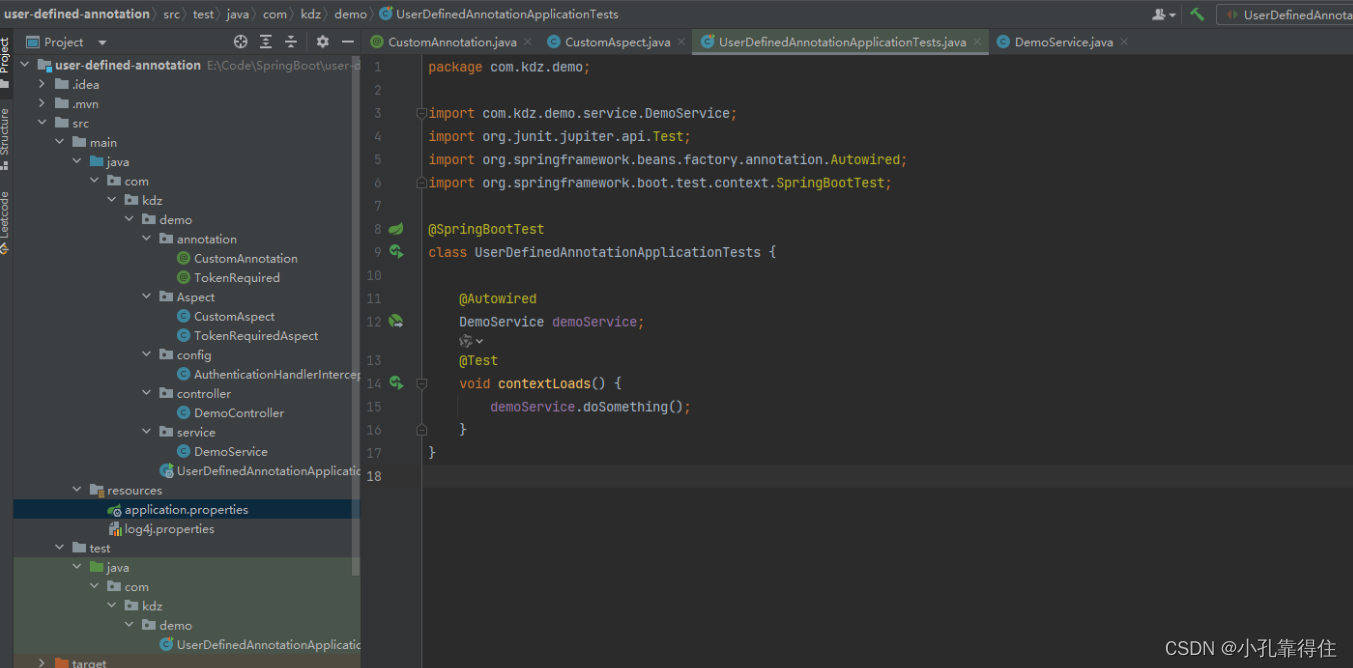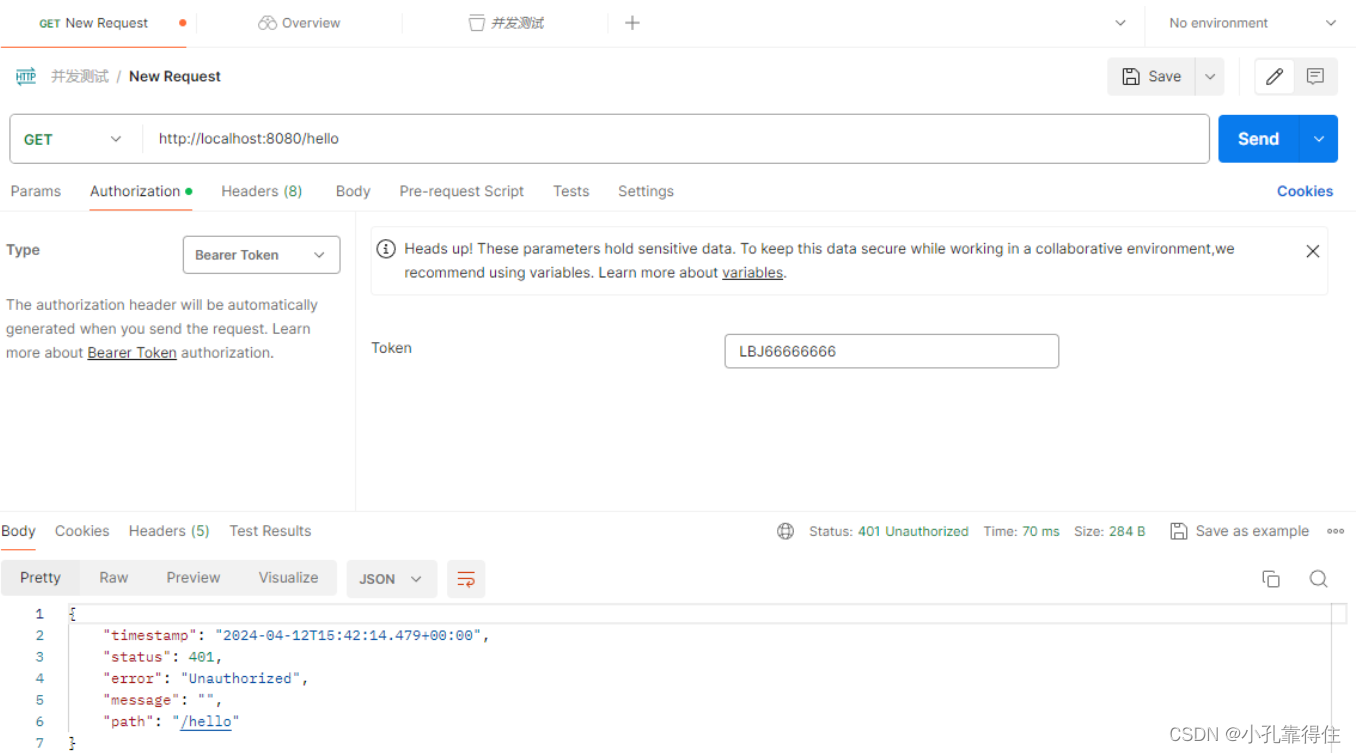SpringBoot-自定义注解AOP实现及拦截器示例
一、四大元注解
当你在编写自定义注解时,@Target、@Retention、@Documented 和 @Inherited 是四个你可能会用到的元注解,它们可以帮助你更好地定义和使用注解。
1、@Target
@Target 注解用于指定注解可以应用的程序元素类型。它的值是一个 ElementType 数组,表示该注解可以应用到哪些地方,包括类、接口、方法、字段等。常用的 ElementType 类型包括:
ElementType.TYPE:类、接口、枚举ElementType.METHOD:方法ElementType.FIELD:字段ElementType.PARAMETER:方法参数ElementType.CONSTRUCTOR:构造方法ElementType.LOCAL_VARIABLE:局部变量ElementType.ANNOTATION_TYPE:注解类型ElementType.PACKAGE:包
例如,如果你希望你的注解只能应用在方法上,你可以这样定义:
@Target(ElementType.METHOD)
2、@Retention
@Retention 注解用于指定注解的保留策略,即注解在编译时、运行时或者在类文件中都保留。它的值是一个 RetentionPolicy 枚举,包括:
RetentionPolicy.SOURCE:注解仅保留在源代码中,在编译时丢弃RetentionPolicy.CLASS:注解保留到类文件中,在运行时丢弃(默认值)RetentionPolicy.RUNTIME:注解保留到运行时,可以通过反射获取
例如,如果你希望你的注解在运行时可用,你可以这样定义:
@Retention(RetentionPolicy.RUNTIME)
3、@Documented
@Documented 注解表示该注解应该被 javadoc 工具记录,因此可以在生成的文档中看到该注解及其说明。它没有任何属性,只需将其放在注解声明之前即可。
例如:
@Documented
@Target(ElementType.METHOD)
@Retention(RetentionPolicy.RUNTIME)
public @interface MyAnnotation {// 注解的定义
}
在生成的文档中,你将能够看到使用了 MyAnnotation 的地方以及相关说明。
4、@Inherited
@Inherited 注解表示该注解可以被子类继承。当一个类使用了被 @Inherited 注解的注解时,其子类也会继承该注解。需要注意的是,@Inherited 只对类的继承有效,对接口、方法、字段等不起作用。
例如:
@Inherited
@Target(ElementType.TYPE)
@Retention(RetentionPolicy.RUNTIME)
public @interface MyAnnotation {// 注解的定义
}
在这个例子中,如果一个父类被 @MyAnnotation 注解修饰,在子类中同样会被继承。
这些元注解可以帮助你更灵活地定义和使用自定义注解,根据具体需求选择合适的元注解来控制注解的行为。
二、自定义注解实现
1、创建注解
自定义注解:CustomAnnotation
package com.kdz.demo.annotation;import java.lang.annotation.ElementType;
import java.lang.annotation.Retention;
import java.lang.annotation.RetentionPolicy;
import java.lang.annotation.Target;@Target(ElementType.METHOD)
@Retention(RetentionPolicy.RUNTIME)
public @interface CustomAnnotation {String value1() default "";String value2() default "";
}
2、AOP实现
创建AOP切面类CustomAspect,指定自定义注解为切入点
指定自定义注解为切入点,定义了切入点表达式和前后通知
package com.kdz.demo.Aspect;import com.kdz.demo.annotation.CustomAnnotation;
import lombok.extern.slf4j.Slf4j;
import org.aspectj.lang.ProceedingJoinPoint;
import org.aspectj.lang.annotation.*;
import org.slf4j.Logger;
import org.slf4j.LoggerFactory;
import org.springframework.stereotype.Component;
@Slf4j
@Aspect
@Component
public class CustomAspect {private static final Logger logger = LoggerFactory.getLogger(CustomAspect.class);//指定自定义注解为切入点@Pointcut("@annotation(customAnnotation)")public void customAnnotationPointcut(CustomAnnotation customAnnotation) {}@Before("@annotation(customAnnotation)")public void beforeAdvice(CustomAnnotation customAnnotation) {System.out.println("Before advice: " + customAnnotation.value1() + " - " + customAnnotation.value2());}@After("@annotation(customAnnotation)")public void afterAdvice(CustomAnnotation customAnnotation) {System.out.println("After advice: " + customAnnotation.value1() + " - " + customAnnotation.value2());}@Around("@annotation(customAnnotation)")public Object aroundAdvice(ProceedingJoinPoint joinPoint, CustomAnnotation customAnnotation) throws Throwable {long startTime = System.currentTimeMillis();Object result = joinPoint.proceed();long endTime = System.currentTimeMillis();long executionTime = endTime - startTime;logger.info("Method: " + joinPoint.getSignature().getName());logger.info("Execution Time: " + executionTime + "ms");Object[] args = joinPoint.getArgs();for (int i = 0; i < args.length; i++) {logger.info("Parameter " + (i + 1) + ": " + args[i]);}logger.info("Annotation: " + customAnnotation.value1() + " - " + customAnnotation.value2());return result;}
}在这个更新后的切面类中,我们使用了@Around通知来围绕目标方法的执行。在方法执行前记录了开始时间,在方法执行后记录了结束时间,并计算了方法的执行时间。我们还获取了方法的参数,并将这些信息都记录在日志中。
3、使用自定义注解
package com.kdz.demo.service;import com.kdz.demo.annotation.CustomAnnotation;
import org.springframework.stereotype.Service;@Service
public class DemoService {@CustomAnnotation(value1 = "湖人总冠军", value2 = "666LBJ666")public void doSomething() {System.out.println("Doing something...");}
}4、测试

package com.kdz.demo;import com.kdz.demo.service.DemoService;
import org.junit.jupiter.api.Test;
import org.springframework.beans.factory.annotation.Autowired;
import org.springframework.boot.test.context.SpringBootTest;@SpringBootTest
class UserDefinedAnnotationApplicationTests {@AutowiredDemoService demoService;@Testvoid contextLoads() {demoService.doSomething();}
}
三、配合MVC拦截器判断是否携带token
1、创建注解
自定义注解:TokenRequired
package com.kdz.demo.annotation;import java.lang.annotation.ElementType;
import java.lang.annotation.Retention;
import java.lang.annotation.RetentionPolicy;
import java.lang.annotation.Target;@Target(ElementType.METHOD)
@Retention(RetentionPolicy.RUNTIME)
public @interface TokenRequired {
}
2、AOP实现
创建AOP切面类TokenRequiredAspect,指定自定义注解为切入点
指定自定义注解为切入点,定义了切入点表达式前置通知
package com.kdz.demo.Aspect;import org.aspectj.lang.annotation.Aspect;
import org.aspectj.lang.annotation.Before;
import org.slf4j.Logger;
import org.slf4j.LoggerFactory;
import org.springframework.stereotype.Component;@Aspect
@Component
public class TokenRequiredAspect {private static final Logger logger = LoggerFactory.getLogger(TokenRequiredAspect.class);@Before("@annotation(com.kdz.demo.annotation.TokenRequired)")public void beforeTokenRequiredMethod() {logger.info("Executing method with TokenRequired annotation...");}
}
3、使用自定义注解
package com.kdz.demo.controller;import com.kdz.demo.annotation.TokenRequired;
import org.springframework.web.bind.annotation.GetMapping;
import org.springframework.web.bind.annotation.RestController;@RestController
public class DemoController {@GetMapping("/hello")@TokenRequiredpublic String hello() {return "Hello, World!";}
}
4、配置启动类
package com.kdz.demo;import com.kdz.demo.config.AuthenticationHandlerInterceptor;
import org.springframework.boot.SpringApplication;
import org.springframework.boot.autoconfigure.SpringBootApplication;
import org.springframework.context.annotation.ComponentScan;
import org.springframework.web.servlet.config.annotation.InterceptorRegistry;
import org.springframework.web.servlet.config.annotation.WebMvcConfigurer;@SpringBootApplication
public class UserDefinedAnnotationApplication implements WebMvcConfigurer {public static void main(String[] args) {SpringApplication.run(UserDefinedAnnotationApplication.class, args);}@Overridepublic void addInterceptors(InterceptorRegistry registry) {registry.addInterceptor(new AuthenticationHandlerInterceptor());}}
我们的应用程序的启动类 UserDefinedAnnotationApplication 上添加了 @SpringBootApplication 注解,并实现了 WebMvcConfigurer 接口,并重写了 addInterceptors 方法,在这个方法中注册了我们的拦截器 AuthenticationHandlerInterceptor。这样,拦截器就会被正确地加载和注册到应用程序中。
5、拦截器实现
拦截器判断是否使用注解及是否携带特定token
package com.kdz.demo.config;
import javax.servlet.http.HttpServletRequest;
import javax.servlet.http.HttpServletResponse;import com.kdz.demo.annotation.TokenRequired;
import org.slf4j.Logger;
import org.slf4j.LoggerFactory;
import org.springframework.stereotype.Component;
import org.springframework.web.method.HandlerMethod;
import org.springframework.web.servlet.HandlerInterceptor;
import org.springframework.web.servlet.ModelAndView;@Component
public class AuthenticationHandlerInterceptor implements HandlerInterceptor {private static final Logger logger = LoggerFactory.getLogger(AuthenticationHandlerInterceptor.class);@Overridepublic boolean preHandle(HttpServletRequest request, HttpServletResponse response, Object handler) throws Exception {logger.debug("进入拦截器, URL: {}", request.getServletPath());if (!(handler instanceof HandlerMethod)) {return true;}HandlerMethod handlerMethod = (HandlerMethod) handler;// 检查请求的方法是否添加了 TokenRequired 注解if (!handlerMethod.hasMethodAnnotation(TokenRequired.class)) {logger.debug("接口未添加 TokenRequired 注解,直接放行");return true;}// 获取请求中的 tokenString token = request.getHeader("Authorization");// 进行 token 验证if (token != null && token.equals("Bearer LBJ666")) {return true; // Token 验证通过,允许请求通过} else {// Token 验证失败,返回未授权错误response.sendError(HttpServletResponse.SC_UNAUTHORIZED, "Unauthorized");return false;}}@Overridepublic void postHandle(HttpServletRequest request, HttpServletResponse response, Object handler, ModelAndView modelAndView) throws Exception {}@Overridepublic void afterCompletion(HttpServletRequest request, HttpServletResponse response, Object handler, Exception ex) throws Exception {}
}6、测试效果
1)未使用自定义注解TokenRequired


2)使用注解
使用正确token


使用错误token


SpringBoot-自定义注解AOP实现及拦截器示例 到此完结,笔者归纳、创作不易,大佬们给个3连再起飞吧



——Sensorless之扩展反电动势EEMF)















